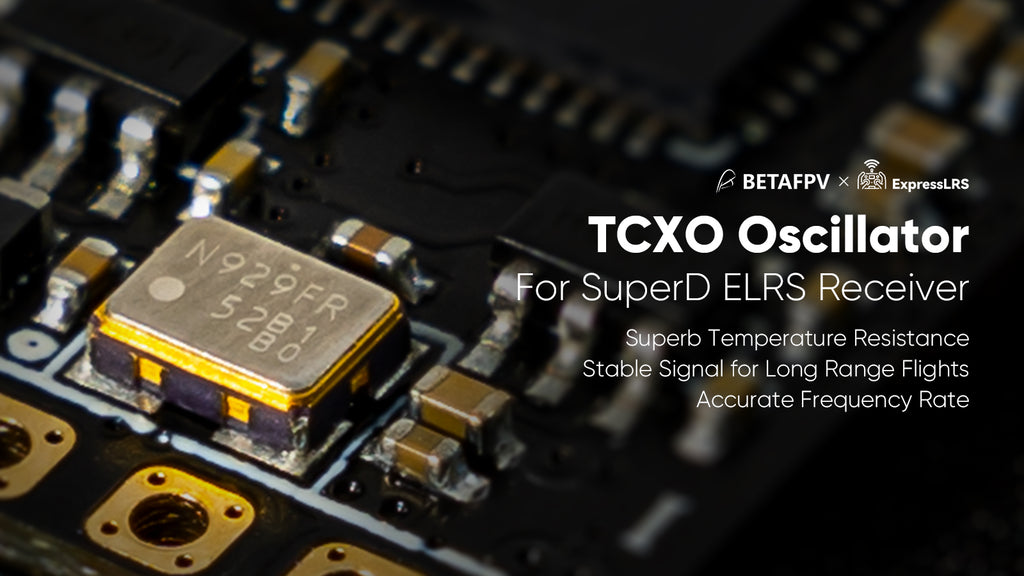
Learn FPV!
FPV made simple!

BETAFPV SuperD ELRS is the first True Diversity Receiver that applies two antennas, dual receiver chains, and TCXO (temperature compensated crystal oscillator) tech, achieving a super accurate frequency rate and excellent performance in extreme temperature environments. It offers 2.4GHz and 915MHz/868MHz versions, and greatly fulfills the requirements of reliability for long-range flying, aerial photography, or FPV freestyle tricks.
Check out all our Receivers and the rest of our BetaFPV Products!
A ton of ExpressLRS items are available now!
Recommend ExpressLRS Recovery Dongle for flashing or recovering the receiver.

SuperD ELRS Diversity Receiver is built-in a TCXO (temperature compensated crystal oscillator), which is shared by two RF chips for a super accurate clock source. The true diversity receiver including two RF chips and PA+LNA will generate a large amount of heat when working. With the high-quality TCXO, it can withstand extreme temperatures with no fear of heat and cold, continuously outputting accurate frequency for long-range flight. Click to learn more about the TCXO.

SuperD ELRS Diversity Receiver has dual RF receiver chains with two antennas, ensuring longer and more stable flying for FPV drones and RC airplanes. Choosing a suitable receiver to fly quadcopter or other RC models is very important. BETAFPV ExpressLRS Receivers including ELRS Lite, Nano, Micro, and the newest SuperD, greatly fulfill pilots' requirements for FPV flying.
| SuperD RX | Micro RX | Nano RX | Lite RX | |
| Weight |
1.1g (2.4GHz), 1.2g (915/868MHz) |
3.5g (RX only) | 0.7g (RX only) | 0.47g (Tower), 0.53g (Flat) |
| Antenna | IPEX MHF1 + T antenna | IPEX MHF1 + T antenna | IPEX MHF1 + T antenna | SMD ceramic antenna |
| MCU | ESP32-PICO-D4 | ESP8285 |
ESP8285 |
ESP8285 |
| RF Chip |
Dual SX128X + Dual PA (2.4GHz), Dual SX1276 (915/868MHz) |
SX128X | SX128X + PA, SX1276 + PA | SX128X |
| Frequency | 2.4GHz ISM, 915MHz (FCC), 868MHz (EU) | 2.4GHz ISM | 2.4GHz ISM, 915MHz (FCC), 868MHz (EU) |
2.4GHz ISM |
| Telemetry Power | 100mW | 17mW | 100mW | 17mW |
| Serial Output Protocol | CRSF | PWM or CRSF | CRSF | CRSF |
| Model Type | FPV Drone, Fixed-wing aircraft | Fixed-wing aircraft, Helicopter, RC Cars, RC Boats | FPV Drone | Whoop Drone |


SuperD receiver RGB status indication is shown below.
| RGB Color | Status | Description |
| Rainbow | Fade effect | Power on |
| Green | Slow flash | WIFI upgrading mode |
| Red | Quick flash | No RF chip detected |
| Orange | Double flash | Binding mode |
| Orange | Triple flash | Connected, but mismatched model-match configuration |
| Orange | Slow flash | Waiting for connection |
| Solid on | Connected and color indicates packet rate |
The RGB light color corresponding to the packet rate is shown in the figure below.
2.4GHz:

Note: F1000 and F500 are packet rates in FLRC mode, providing faster modulation and lower latency, but at the same time having shorter reception distance than normal Lora mode. This mode is great for racers.
D500 and D250 are packet rates in DVDA (Deja Vu Diversity Aid) mode. This mode works at the F1000 data packet rate of FLRC mode, providing better link connection in the case of complex interference by sending the same data packet multiple times. D500 and D250 indicate that the same data packet is sent twice and four times respectively.
915MHz/868MHz:

Note: D50 is a unique mode of ELRS Team900. Under the 200Hz refresh rate of Lora mode, the same data packet is repeatedly sent four times, and the receiving distance is equivalent to 200Hz.
100Hz Full is a mode that realizes 16-channel full-resolution output at the 200Hz refresh rate of Lora mode, and the receiving distance is equivalent to 200Hz.
ExpressLRS uses the Crossfire serial protocol (AKA CRSF protocol) to communicate between the SuperD diversity receiver and the flight controller board. Take the flight controller using the Betaflight firmware as an example to introduce its wiring and port configuration.
The connection between the SuperD diversity receiver and the flight controller is shown in the figure below

Connect the flight controller to the Betaflight Configurator for basic configuration. First, on the "Port" page, enable the flight controller serial port (take UART1 as an example) as "Serial Rx".

On the configuration page, set Receiver Mode to Serial (via UART) and Serial Receiver Provider to CRSF.

The default firmware of the SuperD diversity receiver uses the ExpressLRS V3.0.0 protocol and has no preset binding phrase. Therefore, the firmware version of the transmitter module must be ExpressLRS V3.0.0 or later versions. Both the receiver and transmitter module should not have any binding phrase.
Note: After binding once, the receiver will remember the autosaved binding phrase and device. Further restarting of the device will be bound automatically without the need for a rebinding process.
The 915MHz/868MHz default firmware is ELRS V3.3.0. The official version has not yet been released. It will be updated synchronously with the ELRS V3.3 version. Then you can click the latest ELRS Configurator Nightly to operate. Select the target device ''BETAFPV SuperD 900MHz RX''.
Note: Firmware for 915MHz/868MHz is currently self-compiled firmware.

ExpressLRS is an open-source RC link for RC applications. Everyone could find this project on Github or join the discussion in Facebook Group.


0 of 3 items selected